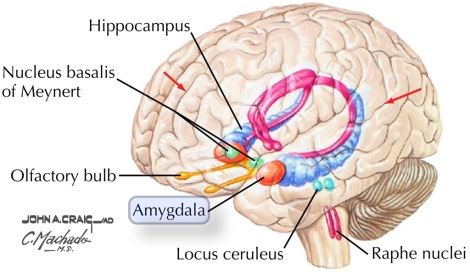
The amygdala of the human brain is placed somewhat strategically at dorsomedial part (above and inside) of temporal lobe, anteriorly (in front) of the hippocampus and close to the tail of the caudate nucleus.
Training the brain to treat itself is a promising therapy for traumatic stress. The training uses an auditory or visual signal that corresponds to the activity of a particular brain region, called neurofeedback, which can guide people to regulate their own brain activity. However, treating stress-related disorders requires accessing the amygdala that is difficult to reach with typical neurofeedback methods. This activity has only been measured using fMRI, which is costly and poorly accessible.
“The major advancement of this new tool is the ability to use a low-cost and accessible imaging method such as EEG to depict deeply located brain activity,” said Dr. Talma Hendler and Jackob Keynan, a PhD student in Hendler’s laboratory. The researchers built upon a new imaging tool they had developed in a previous study that uses EEG to measure changes in amygdala activity, indicated by its “electrical fingerprint”. With the new tool, 42 participants were trained to reduce an auditory feedback corresponding to their amygdala activity using any mental strategies they found effective.
During this neurofeedback task, the participants learned to modulate their own amygdala electrical activity. This also led to improved downregulation of blood-oxygen level dependent signals of the amygdala, an indicator of regional activation measured with fMRI. In another experiment with 40 participants, learning to downregulate amygdala activity could actually improve behavioral emotion regulation. They showed this using a behavioral task invoking emotional processing in the amygdala. The findings show that with this new imaging tool, people can modify both the neural processes and behavioral manifestations of their emotions.
“We have long known that there might be ways to tune down the amygdala through biofeedback, meditation, or even the effects of placebos,” said John Krystal, Editor of Biological Psychiatry. “It is an exciting idea that perhaps direct feedback on the level of activity of the amygdala can be used to help people gain control of their emotional responses.”
The participants in the study were healthy, so the tool still needs to be tested in the context of real-life trauma. However, according to the authors, this new method has huge clinical implications.
The approach “holds the promise of reaching anyone anywhere,” said Hendler and Keynan. The mobility and low cost of EEG contribute to its potential for a home-stationed bedside treatment for recent trauma patients or for stress resilience training for people prone to trauma. https://www.elsevier.com/about/press-releases/research-and-journals/learning-to-turn-down-your-amygdala-can-modify-your-emotions








Recent Comments